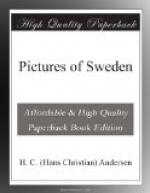The rainbow has placed one foot high up on Soedermalm’s churchyard. Where the rainbow touches the earth, there lie treasures buried, is a popular belief here. The rainbow rests on a grave up there: Stagnalius rests here, Sweden’s most gifted singer, so young and so unhappy; and in the same grave lies Nicander, he who sang about King Enzio, and of “Lejonet i Oken;"[L] who sang with a bleeding heart: the fresh vine-leaf cooled the wound and killed the singer. Peace be with his dust—may his songs live for ever! We go to your grave where the rainbow points. The view from here is splendid. The houses rise terrace-like in the steep, paved streets; the foot-passengers can, however, shorten the way by going through narrow lanes, and up steps made of thick beams, and always with a prospect downwards of the water, of the rocks and green trees! It is delightful to dwell here, it is healthy to dwell here, but it is not genteel, as it is by Brunkaberg’s sand-ridge, yet it will become so: Stockholm’s “Strada Balbi” will one day arise on Soedermalm’s rocky ground.
[Footnote L: “The Lion in the desert;” i.e. Napoleon.]
We stand up here. What other city in the world has a better prospect over the salt fjord, over the fresh lake, over towers, cupolas, heaped-up houses, and a palace, which King Enzio himself might have built, and round about the dark, gloomy forests with oaks, pines and firs, so Scandinavian, dreaming in the declining sun? It is twilight; the night comes on, the lamps are lighted in the city below, the stars are kindled in the firmament above, and the tower of Redderholm’s church rises aloft towards the starry space. The stars shine through there; it is as if cut in lace, but every thread is of cast-iron and of the thickness of beams.
We go down there, and in there, in the stilly eve.—A world of spirits reigns within. See, in the vaulted isles, on carved wooden horses, sits armour, that was once borne by Magnus Ladelaas, Christian the Second, and Charles the Ninth. A thousand flags that once waved to the peal of music and the clang of arms, to the darted javelin and the cannon’s roar, moulder away here: they hang in long rags from the staff, and the staves lie cast aside, where the flag has long since become dust. Almost all the Kings of Sweden slumber in silver and copper coffins within these walls. From the altar aisle we look through the open-grated door, in between piled-up drums and hanging flags: here is preserved a bloody tunic, and in the coffin are the remains of Gustavus Adolphus. Who is that dead opposite neighbour in the chapel, across there in the other side-aisle of the church? There, below a glass lid, lies a dress shot through, and on the floor stands a pair of long, thick boots—they belonged to the hero-King, the wanderer, Charles XII., whose realm is now this narrow coffin.
How sacred it is here under this vaulted roof! The mightiest men of centuries are gathered together here, perishable as these moth-eaten flags—mute and yet so eloquent. And without there is life and activity: the world goes on in its old course; generations change in the old houses; the houses change—yet Stockholm is always the heart of Sweden, Birger’s city, whose features are continually renewed, continually beautified.




